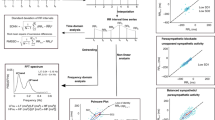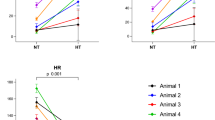Abstract
Objective
To assess the use of continuous heart rate variability (HRV) as a predictor of brain injury severity in newborns with moderate to severe HIE that undergo therapeutic hypothermia.
Study Design
Two cohorts of newborns (n1 = 55, n2 = 41) with moderate to severe hypoxic-ischemic encephalopathy previously treated with therapeutic hypothermia. HRV was characterized by root mean square in the short time scales (RMSS) during therapeutic hypothermia and through completion of rewarming. A logistic regression and Naïve Bayes models were developed to predict the MRI outcome of the infants using RMSS. The encephalopathy grade and gender were used as control variables.
Results
For both cohorts, the predicted outcomes were compared with the observed outcomes. Our algorithms were able to predict the outcomes with an area under the receiver operating characteristic curve of about 0.8.
Conclusions
HRV assessed by RMSS can predict severity of brain injury in newborns with HIE.
This is a preview of subscription content, access via your institution
Access options
Subscribe to this journal
Receive 12 print issues and online access
$259.00 per year
only $21.58 per issue
Buy this article
- Purchase on Springer Link
- Instant access to full article PDF
Prices may be subject to local taxes which are calculated during checkout



Similar content being viewed by others
Data availability
The datasets generated during and/or analyzed during the current study are available from the corresponding author on reasonable request.
Code availability
Matlab code used to analyze the data is available upon request.
References
Kurinczuk JJ, White-Koning M, Badawi N. Epidemiology of neonatal encephalopathy and hypoxic-ischaemic encephalopathy. Early Hum Dev. 2010;86:329–38.
Liu L, Oza S, Hogan D, Chu Y, Perin J, Zhu J, et al. Global, regional, and national causes of under-5 mortality in 2000-15: an updated systematic analysis with implications for the Sustainable Development Goals. Lancet. 2016;388:3027–35.
Shankaran S, Laptook AR, Ehrenkranz RA, Tyson JE, McDonald SA, Donovan EF, et al. Whole-body hypothermia for neonates with hypoxic-ischemic encephalopathy. N. Engl J Med. 2005;353:1574–84.
Dilenge ME, Majnemer A, Shevell MI. Long-term developmental outcome of asphyxiated term neonates. J Child Neurol. 2001;16:781–92.
Shankaran S, Woldt E, Koepke T, Bedard MP, Nandyal R. Acute neonatal morbidity and long-term central nervous system sequelae of perinatal asphyxia in term infants. Early Hum Dev. 1991;25:135–48.
Li R, Lee JK, Govindan RB, Graham EM, Everett AD, Perin J, et al. Plasma biomarkers of evolving encephalopathy and brain injury in neonates with hypoxic-ischemic encephalopathy. J Pediatr 2023;252:146–53.e2.
Massaro AN, Chang T, Kadom N, Tsuchida T, Scafidi J, Glass P, et al. Biomarkers of brain injury in neonatal encephalopathy treated with hypothermia. J Pediatr. 2012;161:434–40.
Kota S, Massaro AN, Chang T, Al-Shargabi T, Cristante C, Vezina G, et al. Prognostic value of continuous electroencephalogram delta power in neonates with hypoxic-ischemic encephalopathy. J Child Neurol. 2020;35:517–25.
Jain SV, Mathur A, Srinivasakumar P, Wallendorf M, Culver JP, Zempel JM. Prediction of neonatal seizures in hypoxic-ischemic encephalopathy using Electroencephalograph power analyses. Pediatr Neurol. 2017;67:64–70.e62.
Korotchikova I, Stevenson NJ, Walsh BH, Murray DM, Boylan GB. Quantitative EEG analysis in neonatal hypoxic ischaemic encephalopathy. Clin Neurophysiol. 2011;122:1671–8.
Das Y, Wang X, Kota S, Zhang R, Liu H, Chalak LF. Neurovascular coupling (NVC) in newborns using processed EEG versus amplitude-EEG. Sci Rep. 2021;11:9426.
Govindan RB, Massaro AN, Al-Shargabi T, Andescavage NN, Chang T, Glass P, et al. Detrended fluctuation analysis of non-stationary cardiac beat-to-beat interval of sick infants. Europhys Lett. 2014;108:40005.
Govindan RB, Massaro A, Vezina G, Chang T, du Plessis A. Identifying an optimal epoch length for spectral analysis of heart rate of critically-ill infants. Comput Biol Med. 2019;113:103391.
Vergales BD, Zanelli SA, Matsumoto JA, Goodkin HP, Lake DE, Moorman JR, et al. Depressed heart rate variability is associated with abnormal EEG, MRI, and death in neonates with hypoxic ischemic encephalopathy. Am J Perinatol. 2014;31:855–62.
Goulding RM, Stevenson NJ, Murray DM, Livingstone V, Filan PM, Boylan GB. Heart rate variability in hypoxic ischaemic encephalopathy: correlation with EEG grade and two-year neurodevelopmental outcome. Pediatr Res. 2015;77:681–7.
Latremouille S, Lam J, Shalish W, Sant’Anna G. Neonatal heart rate variability: a contemporary scoping review of analysis methods and clinical applications. BMJ Open. 2021;11:e055209.
Oliveira V, von Rosenberg W, Montaldo P, Adjei T, Mendoza J, Shivamurthappa V, et al. Early postnatal heart rate variability in healthy newborn infants. Front Physiol. 2019;10:922.
Pedersen MV, Andelius TCK, Andersen HB, Kyng KJ, Henriksen TB. Hypothermia and heart rate variability in a healthy newborn piglet model. Sci Rep. 2022;12:18282.
Sarnat HB, Sarnat MS. Neonatal encephalopathy following fetal distress. A clinical and electroencephalographic study. Arch Neurol. 1976;33:696–705.
Ulusar UD, Govindan RB, Wilson JD, Lowery CL, Preissl H, Eswaran H. Adaptive rule based fetal QRS complex detection using Hilbert transform. Annu Int Conf IEEE Eng Med Biol Soc. 2009;2009:4666–9.
Govindan RB, Al-Shargabi T, Metzler M, Andescavage NN, Joshi R, du Plessis A. A spike correction approach for variability analysis of heart rate sick infants. Phys A: Stat Mech Appl. 2016;444:35–42.
Shankaran S, Barnes PD, Hintz SR, Laptook AR, Zaterka-Baxter KM, McDonald SA, et al. Brain injury following trial of hypothermia for neonatal hypoxic-ischaemic encephalopathy. Arch Dis Child Fetal Neonatal Ed. 2012;97:F398–404.
Govindan RB, Massaro AN, Niforatos N, du Plessis A. Mitigating the effect of non-stationarity in spectral analysis-an application to neonate heart rate analysis. Comput Biol Med. 2013;43:2001–6.
Massaro AN, Govindan RB, Al-Shargabi T, Andescavage NN, Metzler M, Chang T, et al. Heart rate variability in encephalopathic newborns during and after therapeutic hypothermia. J Perinatol. 2014;34:836–41.
Stone ML, Tatum PM, Weitkamp JH, Mukherjee AB, Attridge J, McGahren ED, et al. Abnormal heart rate characteristics before clinical diagnosis of necrotizing enterocolitis. J Perinatol. 2013;33:847–50.
Doheny KK, Palmer C, Browning KN, Jairath P, Liao D, He F, et al. Diminished vagal tone is a predictive biomarker of necrotizing enterocolitis-risk in preterm infants. Neurogastroenterol Motil. 2014;26:832–40.
Al-Shargabi T, Reich D, Govindan RB, Shankar S, Metzler M, Cristante C, et al. Changes in autonomic tone in premature infants developing necrotizing Enterocolitis. Am J Perinatol. 2018;35:1079–86.
Fairchild KD, O’Shea TM. Heart rate characteristics: physiomarkers for detection of late-onset neonatal sepsis. Clin Perinatol. 2010;37:581–98.
Fairchild KD, Saucerman JJ, Raynor LL, Sivak JA, Xiao Y, Lake DE, et al. Endotoxin depresses heart rate variability in mice: cytokine and steroid effects. Am J Physiol Regul Integr Comp Physiol. 2009;297:R1019–1027.
Al-Shargabi T, Govindan RB, Dave R, Metzler M, Wang Y, du Plessis A, et al. Inflammatory cytokine response and reduced heart rate variability in newborns with hypoxic-ischemic encephalopathy. J Perinatol. 2017;37:668–72.
Zijlmans M, Flanagan D, Gotman J. Heart rate changes and ECG abnormalities during epileptic seizures: prevalence and definition of an objective clinical sign. Epilepsia. 2002;43:847–54.
Nei M. Cardiac effects of seizures. Epilepsy Curr. 2009;9:91–95.
Massaro AN, Campbell HE, Metzler M, Al-Shargabi T, Wang Y, du Plessis A, et al. Effect of temperature on heart rate variability in neonatal ICU patients with hypoxic-ischemic Encephalopathy. Pediatr Crit Care Med. 2017;18:349–54.
Al Amrani F, Kwan S, Gilbert G, Saint-Martin C, Shevell M, Wintermark P. Early imaging and adverse neurodevelopmental outcome in asphyxiated newborns treated with Hypothermia. Pediatr Neurol. 2017;73:20–27.
Douglas-Escobar M, Weiss MD. Biomarkers of hypoxic-ischemic encephalopathy in newborns. Front Neurol. 2012;3:144.
Mir IN, Chalak LF. Serum biomarkers to evaluate the integrity of the neurovascular unit. Early Hum Dev. 2014;90:707–11.
Acknowledgements
This work was supported by internal special purpose funds available in the Prenatal Pediatrics Institute, by the Award Number P30 HD040677, UL1RR031988, and KL2 RR031987 from the National Center for Research Resources and by the American Heart Association Grant-in-Aid. We want to thank Patricia Saulino for her editorial assistance. We also want to thank Amaya Sinha for assisting in data cleaning.
Author information
Authors and Affiliations
Contributions
AP and VC carried out the analyses and wrote the paper, GV validated the MRI data, RL collected the EKG data, ADP helped conceive, devise and supervise the experiment and critically edited the manuscript, AM conceived and devised the experiment and wrote the paper and RG conceived and devised the experiment, analyzed the data and wrote the paper.
Corresponding author
Ethics declarations
Competing interests
The authors declare no competing interests.
Additional information
Publisher’s note Springer Nature remains neutral with regard to jurisdictional claims in published maps and institutional affiliations.
Supplementary information
Rights and permissions
Springer Nature or its licensor (e.g. a society or other partner) holds exclusive rights to this article under a publishing agreement with the author(s) or other rightsholder(s); author self-archiving of the accepted manuscript version of this article is solely governed by the terms of such publishing agreement and applicable law.
About this article
Cite this article
Presacco, A., Chirumamilla, V.C., Vezina, G. et al. Prediction of outcome of hypoxic-ischemic encephalopathy in newborns undergoing therapeutic hypothermia using heart rate variability. J Perinatol 44, 521–527 (2024). https://doi.org/10.1038/s41372-023-01754-w
Received:
Revised:
Accepted:
Published:
Issue Date:
DOI: https://doi.org/10.1038/s41372-023-01754-w



